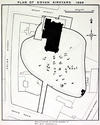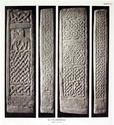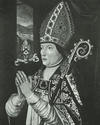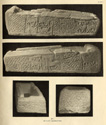Learning and Beliefs
By Thomas Clancy
 Glasgow, if we are to believe the 12th century Lives of its founder and patron, Kentigern (or Mungo), was a community of male Christians in a shaded stream-fed hollow, built on the site of a consecrated but unused cemetery. This suggests its demarcation from the previous belief systems of the Glasgow area: committed to the Christian creed and to one interpretation of its view of living the life of perfection, involving rejection of the world and celibate life in community. If contemporary monastic establishments are anything to go by, it would have been physically marked out from its surroundings as well, probably by some sort of turf rampart.
Glasgow, if we are to believe the 12th century Lives of its founder and patron, Kentigern (or Mungo), was a community of male Christians in a shaded stream-fed hollow, built on the site of a consecrated but unused cemetery. This suggests its demarcation from the previous belief systems of the Glasgow area: committed to the Christian creed and to one interpretation of its view of living the life of perfection, involving rejection of the world and celibate life in community. If contemporary monastic establishments are anything to go by, it would have been physically marked out from its surroundings as well, probably by some sort of turf rampart.
Burial
 You can still see the shape of Govan's similar boundary in its modern churchyard. The consecrated cemetery signifies yet another boundary between earlier beliefs and Christianity. Govan has produced some of the earliest dates for Christian graves in the Glasgow area (in the later 6th-century). Such graves were typically oriented from west to east, just as church buildings were, and they contained few, or more usually no grave-goods: the expectation of the resurrection in the final days did away with the need for the trappings of life in the journey of death. Burial ad sanctos "by the holy ones" was another new feature and something that would continue: the belief in the effectiveness of the power of the holy man and woman, even, perhaps especially after death, and in the presence of that power within his or her relics (bones, clothes, insignia) is one of the radical features of late antique and medieval Christianity. It is to such beliefs that Glasgow owes its initial devotion to its patron saint.
You can still see the shape of Govan's similar boundary in its modern churchyard. The consecrated cemetery signifies yet another boundary between earlier beliefs and Christianity. Govan has produced some of the earliest dates for Christian graves in the Glasgow area (in the later 6th-century). Such graves were typically oriented from west to east, just as church buildings were, and they contained few, or more usually no grave-goods: the expectation of the resurrection in the final days did away with the need for the trappings of life in the journey of death. Burial ad sanctos "by the holy ones" was another new feature and something that would continue: the belief in the effectiveness of the power of the holy man and woman, even, perhaps especially after death, and in the presence of that power within his or her relics (bones, clothes, insignia) is one of the radical features of late antique and medieval Christianity. It is to such beliefs that Glasgow owes its initial devotion to its patron saint.
Monastic Life
 The monastic day would have been oriented around a cycle of prayer and hymns, a cycle itself attuned to the changing liturgy of the year. Prayers, psalms and hymns would all have been in Latin and the need to know Latin created a need for education and literacy. We know little of such matters for Glasgow in the early middle ages. Kentigern, traditionally, was educated by Saint Serf at Culross, but ecclesiastical sites like Glasgow and Govan probably housed lectors who would teach the younger monks and possibly also members of the lay population. That there were religious houses containing scriptoria, or writing workshops, is implied by the probable composition and preservation of early poetry in the local vernacular language, a relative of Welsh, in the Glasgow area, the earliest stratum of the poetry that goes under the name of The Gododdin.
The monastic day would have been oriented around a cycle of prayer and hymns, a cycle itself attuned to the changing liturgy of the year. Prayers, psalms and hymns would all have been in Latin and the need to know Latin created a need for education and literacy. We know little of such matters for Glasgow in the early middle ages. Kentigern, traditionally, was educated by Saint Serf at Culross, but ecclesiastical sites like Glasgow and Govan probably housed lectors who would teach the younger monks and possibly also members of the lay population. That there were religious houses containing scriptoria, or writing workshops, is implied by the probable composition and preservation of early poetry in the local vernacular language, a relative of Welsh, in the Glasgow area, the earliest stratum of the poetry that goes under the name of The Gododdin.
Warrior Society
 That poem is a secular one, mourning the death of young warriors in a disastrous campaign; it upholds and glorifies the belief system of the military aristocracy, beliefs scarcely mitigated by the espousal of Christianity among local rulers. The real conflict between Christianity and other values in the early middle ages was not with latent "paganism", but with the values of the courts of kings like Rhydderch Hen, ruler of Dumbarton in the late 6th century; or Morgant, perhaps the ruler of the area around Glasgow. The conflict is expressed, however formulaically, in the lives of saints, like those of Kentigern. The Christian preacher had to rebuke the values of the military aristocracy, based as it was on violence, on raiding from other neighbouring Christians, on glory in battle and boasting in the mead-hall. Its key strengths could be seen, from a Christian point of view, as vices: they might consider seeking for fame as the vice of pride, bravery in battle as anger, feasting and carousing as gluttony and so on. That is not to imply that the two fields of belief, court and church, did not intersect. The sculpture at Govan, which belongs to the 9th-11th centuries, testifies to networks of patronage and power that bound the two together.
That poem is a secular one, mourning the death of young warriors in a disastrous campaign; it upholds and glorifies the belief system of the military aristocracy, beliefs scarcely mitigated by the espousal of Christianity among local rulers. The real conflict between Christianity and other values in the early middle ages was not with latent "paganism", but with the values of the courts of kings like Rhydderch Hen, ruler of Dumbarton in the late 6th century; or Morgant, perhaps the ruler of the area around Glasgow. The conflict is expressed, however formulaically, in the lives of saints, like those of Kentigern. The Christian preacher had to rebuke the values of the military aristocracy, based as it was on violence, on raiding from other neighbouring Christians, on glory in battle and boasting in the mead-hall. Its key strengths could be seen, from a Christian point of view, as vices: they might consider seeking for fame as the vice of pride, bravery in battle as anger, feasting and carousing as gluttony and so on. That is not to imply that the two fields of belief, court and church, did not intersect. The sculpture at Govan, which belongs to the 9th-11th centuries, testifies to networks of patronage and power that bound the two together.
Cathedral
 The rise of Glasgow as a centre in the 12th century came on the back of such networks, and saw a re-orientation of its role as a promoter of Christian values and learning, a role which would increase and change over the years of the later middle ages. The establishment of Glasgow Cathedral by David I belonged to a period in which the political, ethnic and linguistic nature of the whole area of Clydesdale was being changed. By the 1160s, Glasgow's community seems to consist largely of clerics of non-local origin, though this was no doubt a temporary phenomenon. William the Clerk, in his song on the death of Somerled in 1164, could envisage this community and its bishop standing stoutly against the incoming raids by westerners and northerners. Already a civic conscience seems to be developing, one linked to the Cathedral and its saint. The Cathedral community in the 12th century was drawn from a reformation-minded clerical class, whose sense of what it was to be a Christian was less open-ended than in previous centuries. To this period belongs Glasgow's first and most explicit linkage to the newly powerful papacy, achieved as a means of bypassing southern jurisdiction. Certainly Glasgow shows every sign of being in direct and close touch with developments in belief and education that were sweeping Europe in the 12th and 13th centuries.
The rise of Glasgow as a centre in the 12th century came on the back of such networks, and saw a re-orientation of its role as a promoter of Christian values and learning, a role which would increase and change over the years of the later middle ages. The establishment of Glasgow Cathedral by David I belonged to a period in which the political, ethnic and linguistic nature of the whole area of Clydesdale was being changed. By the 1160s, Glasgow's community seems to consist largely of clerics of non-local origin, though this was no doubt a temporary phenomenon. William the Clerk, in his song on the death of Somerled in 1164, could envisage this community and its bishop standing stoutly against the incoming raids by westerners and northerners. Already a civic conscience seems to be developing, one linked to the Cathedral and its saint. The Cathedral community in the 12th century was drawn from a reformation-minded clerical class, whose sense of what it was to be a Christian was less open-ended than in previous centuries. To this period belongs Glasgow's first and most explicit linkage to the newly powerful papacy, achieved as a means of bypassing southern jurisdiction. Certainly Glasgow shows every sign of being in direct and close touch with developments in belief and education that were sweeping Europe in the 12th and 13th centuries.
University
 If the clerics of Glasgow had to go elsewhere for higher theological training for much of the later middle ages, the establishment of a university here in 1451 changes that. Grammar was taught as well as theology: the universities became key centres for the discontent that, fuelled by the atmosphere of controversy, would lead to the collapse and vilification of much of the distinctive culture that was late medieval Christianity in Scotland, in the period after 1560.
If the clerics of Glasgow had to go elsewhere for higher theological training for much of the later middle ages, the establishment of a university here in 1451 changes that. Grammar was taught as well as theology: the universities became key centres for the discontent that, fuelled by the atmosphere of controversy, would lead to the collapse and vilification of much of the distinctive culture that was late medieval Christianity in Scotland, in the period after 1560.
It is too easy to concentrate on the clerics. From the earliest period until 1560 and beyond, lay people produce evidence of their investment in the beliefs of Christianity, whether that be in our earliest Christian graves in southern Scotland, mostly in non-church contexts, or in their establishment of altars, of collegiate churches, their patronage of parish churches and their devotion to local saints.